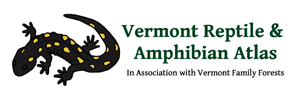Turtles
Although you might stumble upon a turtle at any time of the year, the best time to look for most of them is in the spring as they bask on logs or along the shore of lakes, rivers, ponds, and marshes. In spring the water is still cold and on sunny days turtles bask to raise their body temperatures. An added bonus at this time of year is that much of the annual vegetation has not yet started growing, leaving the turtles much more exposed, visible, and easier to identify. You will probably need binoculars to see them well enough to make an identification. In the late spring and early summer, female turtles are often seen on land while traveling to and from egg-laying sites. When attempting to identify a particular species, note at least three different field markings.
Snakes & Lizards
Snakes bask most often in the spring and fall to raise their body temperatures. It is during these two time periods that they are easiest to locate. During the summer you often have to look under rocks and logs or in the shade to find them. Make sure to check under the loose bark of large dead standing and downed trees in sunny areas. May is the month that many snake species first become active. They can often be found basking in open areas (roads, rock ledges, lawns, etc.) particularly on sunny mornings after a cold night. Check out this video clip from our Rattlers, Peepers & Snappers DVD to see what this type of search for snakes in an open field looks like, and for a quick introduction to some of our snake (and one lizard) species. In the fall many young snakes have been added to the population so this increases your chances of finding one. In late September or early October search along small roads that travel between swamps, marshes, and overgrown fields and wooded hillsides. You can often find snakes as they stop to bask in the roads on their way to a denning site. This link will take you to a clip from our Rattlers, Peepers & Snappers DVD to see what this type of search for snakes during migration looks like, and how you can go about searching for them. If you would like to more easily find the snakes on your property, you could build snake hotels or snake covers (slate). Watch our snake video monitoring video to learn more about what these monitoring methods look like.
Frogs and Salamanders
All amphibians need to stay moist. The best time to find them is during or immediately after a hard rain. Searching along roads at any time of the year during or after a heavy rain should locate a few species. In the spring many species of frog and salamander migrate to nearby ponds and vernal pools to breed. At this time of year they can often be found in and around small ponds at night with a flashlight. Frogs are easier to locate if you learn their calls. On almost any warm evening between April and July some species of frog will be calling. During summer days you will need to look for them in their moist hiding places. Many salamander species can be found under stones and logs or under the bark of logs and dead trees that hold some moisture. Some frogs stay close to water during summer days to retain their moisture. Search the edges of ponds, streams, and marshes to locate them at this time of year.
Check out the videos from our Rattlers, Peepers & Snappers DVD to see what these searches (night-time spring amphibian migration, evening frog searches, and stream salamander searches) look like, and get a feel for how you might go about searching using these methods. Also check out our vernal pool page for some information on how to identify vernal pools, species that use them, and their egg masses.
Handling
Don’t disturb any reptile or amphibian any more than is necessary. If you need to handle them, do so gently. Keep in mind that amphibians need to stay moist and that both reptiles and amphibians can overheat easily. If they start feeling slightly sticky in your hands, they are drying out and you need to moisten them with non-chlorinated water or let them go. Once you have identified them, return them to exactly where you found them. If they were under a piece of cover, return the cover to its place first, then place the animal next to it. This way you will avoid the chance of injuring the animals.
Field Herping Etiquette
It is our responsibility to protect both the animals and their habitat. Review this field herping etiquette sheet produced by Midwest PARC to better understand how to do this.

